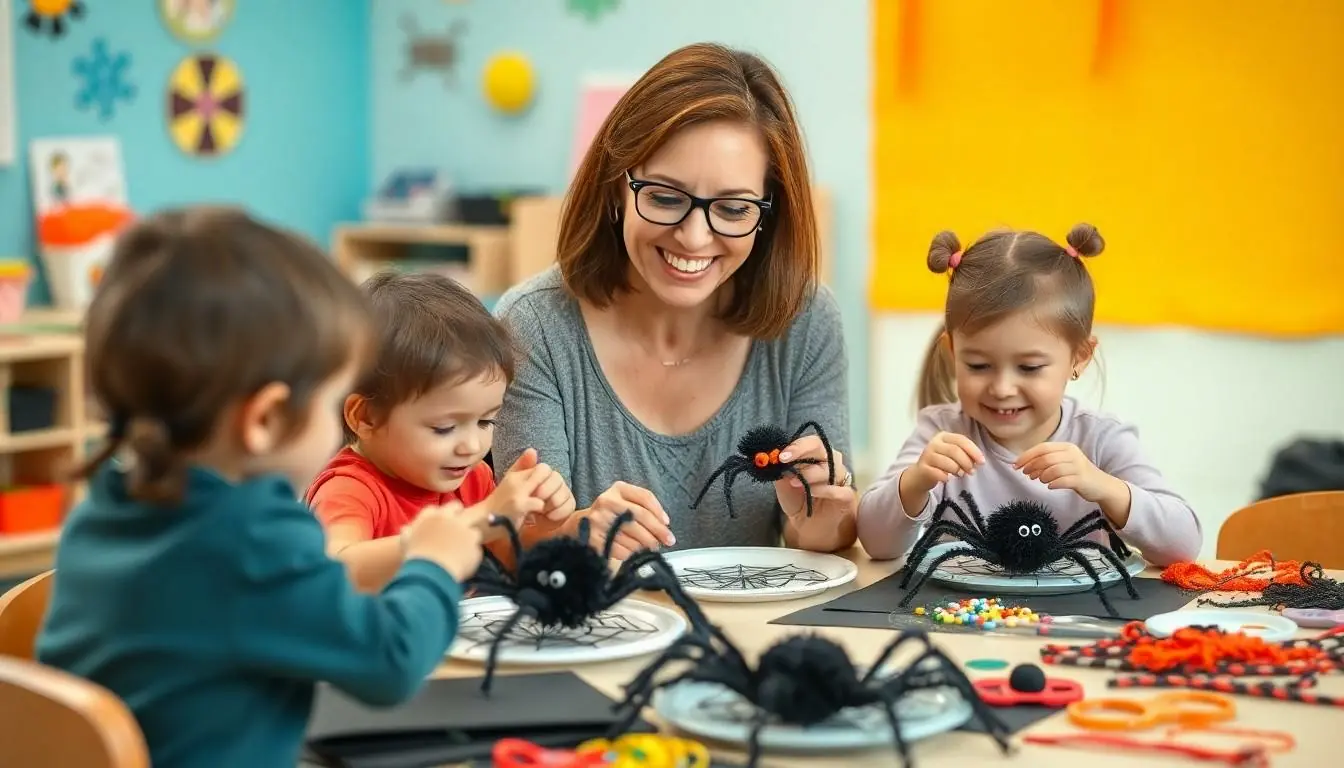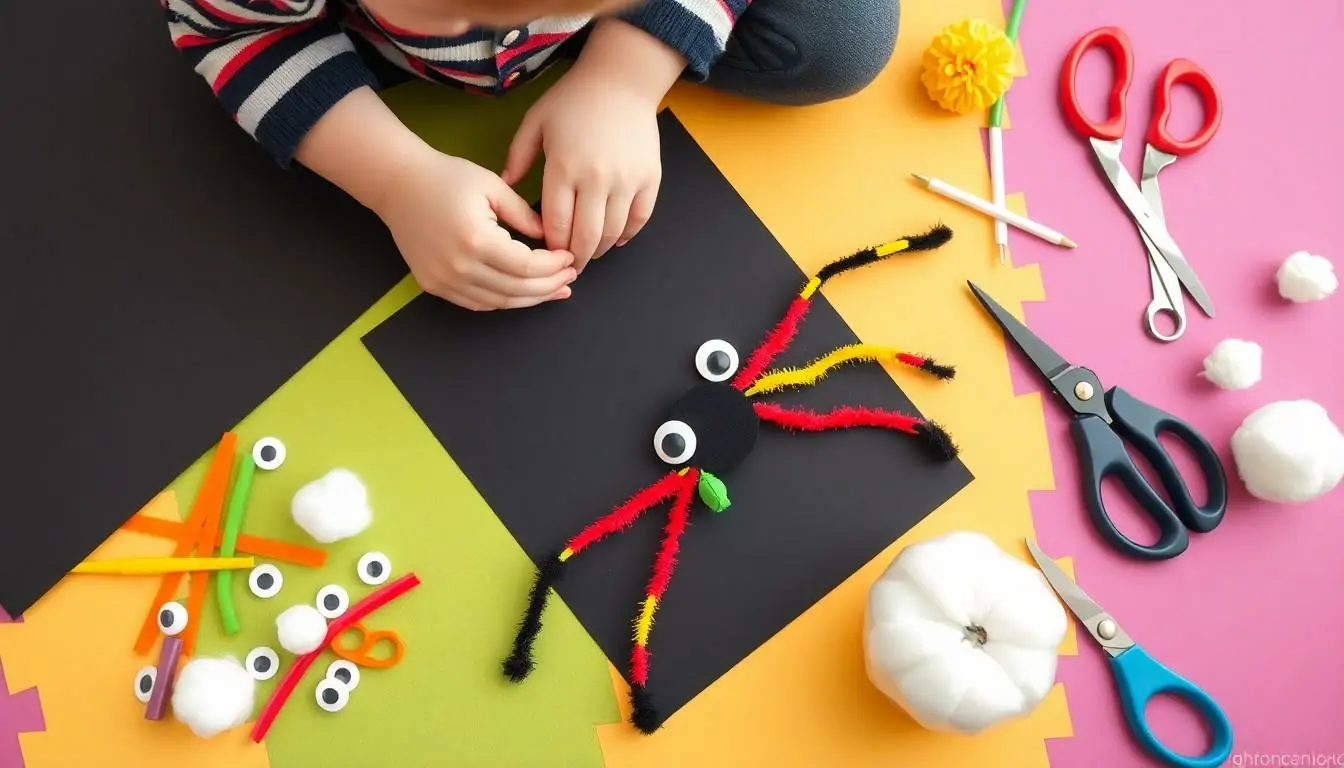Tiny hands and creative minds come together for an eight-legged adventure in preschool spider crafts! These creepy-crawly activities aren’t just fun – they’re perfect for developing fine motor skills and sparking imagination in young learners.
From fuzzy pipe cleaner spiders to paper plate web weavers there’s something magical about transforming simple materials into adorable arachnids. Teachers and parents love these projects because they’re budget-friendly easy to set up and guaranteed to keep little ones engaged while teaching them about these fascinating creatures.
These spider-themed crafts offer the perfect blend of education and entertainment making them an ideal choice for Halloween activities fall season projects or any time kids need a dose of creative fun. Plus they’ll help children overcome common fears of spiders by turning these misunderstood creatures into lovable art pieces.
Table of Contents
ToggleFun Spider Crafts for Preschoolers
These hands-on spider crafts engage preschoolers in creative play while developing essential fine motor skills. Each project uses simple materials found in most craft supplies.
Paper Plate Spider Webs
Paper plate spider webs transform ordinary materials into stunning 3D art pieces. Preschoolers start by painting a white paper plate black or dark blue. After the paint dries, they punch holes around the plate’s edge at 1-inch intervals. Using white yarn, children weave through the holes to create intricate web patterns. Adding silver glitter glue creates a realistic dewdrop effect on the completed web. Small plastic spiders attach easily to the web using glue dots or tape.
Cotton Ball Spiders
Cotton ball spiders offer a tactile experience that preschoolers love exploring. Children color three cotton balls black using washable markers or paint. Joining the cotton balls creates the spider’s body segments. Four pipe cleaners cut in half form eight legs that attach to the body. Googly eyes glued to the front cotton ball bring the spider to life. Small pieces of red pipe cleaner curve into fangs, completing the friendly spider’s face.
Simple Materials for Spider Crafts
Creating spider crafts requires basic art supplies found in most homes or easily purchased from craft stores. These accessible materials transform into engaging spider-themed projects for preschoolers.
Essential Craft Supplies
- Black construction paper for spider bodies
- Pipe cleaners in black or colorful varieties for legs
- Googly eyes in various sizes for facial features
- White yarn or string for spider webs
- Paper plates as craft bases
- Cotton balls for textured bodies
- Black markers or crayons for details
- Craft glue or glue sticks for assembly
- Child-safe scissors for cutting
- Pom poms in assorted sizes
- Paint brushes for decorating
- Washable tempera paint in black white
Safety Considerations
- Store scissors in a designated container out of children’s reach
- Use non-toxic washable paints certified for preschool use
- Select age-appropriate sized materials to prevent choking hazards
- Keep glue sticks capped when not in use
- Choose rounded-tip scissors for preschoolers
- Monitor small items like googly eyes during craft time
- Place newspaper or craft mats to protect surfaces
- Keep wet wipes handy for quick cleanup
- Ensure proper ventilation when using adhesives
- Remove broken or damaged craft supplies immediately
Spider-Themed Learning Activities
Spider-themed activities enhance preschoolers’ understanding of numbers patterns while incorporating movement-based learning. These interactive exercises transform basic educational concepts into engaging spider-centered experiences.
Counting and Math Games
Preschoolers practice counting skills with spider web number matching activities. Children connect numerals 1-10 on printed webs using string or markers to reinforce number recognition. A spider web counting tray filled with plastic spiders enables hands-on addition practice as kids place spiders in different web sections. The “Spider Catch” game involves rolling dice to determine how many toy spiders to collect in cups strengthening number sense through play. Spider-themed pattern cards feature alternating colors shapes allowing children to complete sequences while developing mathematical thinking.
Movement and Songs
“The Itsy Bitsy Spider” fingerplay combines hand motions with rhythm to develop coordination skills. Children stretch wiggle crawl during “Spider Freeze Dance” promoting gross motor development balance. “Eight Little Spiders” counting rhyme incorporates full body movements as kids act out spiders climbing spinning weaving. Action songs like “Spider on the Floor” encourage spatial awareness as preschoolers follow directional instructions to move like spiders across different surfaces. Physical activities include web walking on tape lines spinning silk scarves creating imaginary spider webs through creative movement.
Teaching Opportunities Through Spider Crafts
Spider crafts create dynamic learning environments for preschoolers while developing essential skills through hands-on activities. These engaging projects integrate multiple learning objectives into fun art experiences.
Color Recognition
Color learning thrives through spider craft activities. Black pipe cleaner spiders encourage children to identify dark shades against colored backgrounds. Creating rainbow-colored spider webs helps preschoolers distinguish between primary colors like red, blue, yellow while mixing secondary colors such as purple, green, orange. Sorting colored pom-poms into different web sections reinforces color matching skills. Teachers incorporate color-specific instructions during craft time: “Place the red spider on the blue web” or “Add yellow legs to your brown spider body.”
Fine Motor Skills Development
Spider crafts strengthen small muscle control through precise movements. Threading yarn through paper plate holes develops hand-eye coordination. Attaching pipe cleaner legs requires careful pinching movements. Gluing small materials like googly eyes enhances finger dexterity. Cutting activities with safety scissors improve grip strength. Paint activities allow children to practice brush control while decorating spider bodies. Manipulating cotton balls builds finger strength through pulling, stretching, shaping actions. Children gain confidence in tool handling by using glue sticks, markers, crayons during spider-themed projects.
Seasonal Spider Craft Ideas
Spider crafts adapt perfectly to different seasons throughout the year, offering preschoolers engaging activities that match the changing calendar. Each seasonal variation introduces unique materials and themes while maintaining the core spider-inspired creativity.
Halloween Projects
Black spiders emerge as Halloween craft staples with glow-in-the-dark elements adding spooky charm. Preschoolers create illuminated spider webs using fluorescent yarn on black paper plates, enhanced with metallic paint accents. Cotton ball spiders transform into haunted decorations with orange glitter, plastic fangs, or purple pom-poms. Additional Halloween spider projects include:
- Window clings made from clear contact paper with sparkly spider silhouettes
- Hanging mobiles featuring spooky spiders crafted from foam shapes
- Light-up mason jar spider habitats with LED tea lights
- Paper bag spider puppets decorated with neon paint markers
Fall-Themed Variations
- Leaf spider collages using pressed autumn foliage
- Acorn cap spider bodies with twig legs
- Burlap spider web frames decorated with fall buttons
- Spider habitats created in pumpkin dioramas
Conclusion
Spider crafts offer preschoolers an engaging way to learn while having fun. These activities not only develop essential motor skills but also build confidence and creativity in young learners. Through simple materials and thoughtful guidance children can transform their perception of spiders from scary creatures into delightful artistic expressions.
The versatility of spider-themed crafts makes them perfect for year-round learning opportunities. Whether it’s creating seasonal decorations practicing counting skills or exploring colors these activities provide valuable educational experiences. Parents and teachers can rest assured that these budget-friendly projects will keep their little ones entertained while fostering important developmental milestones.




